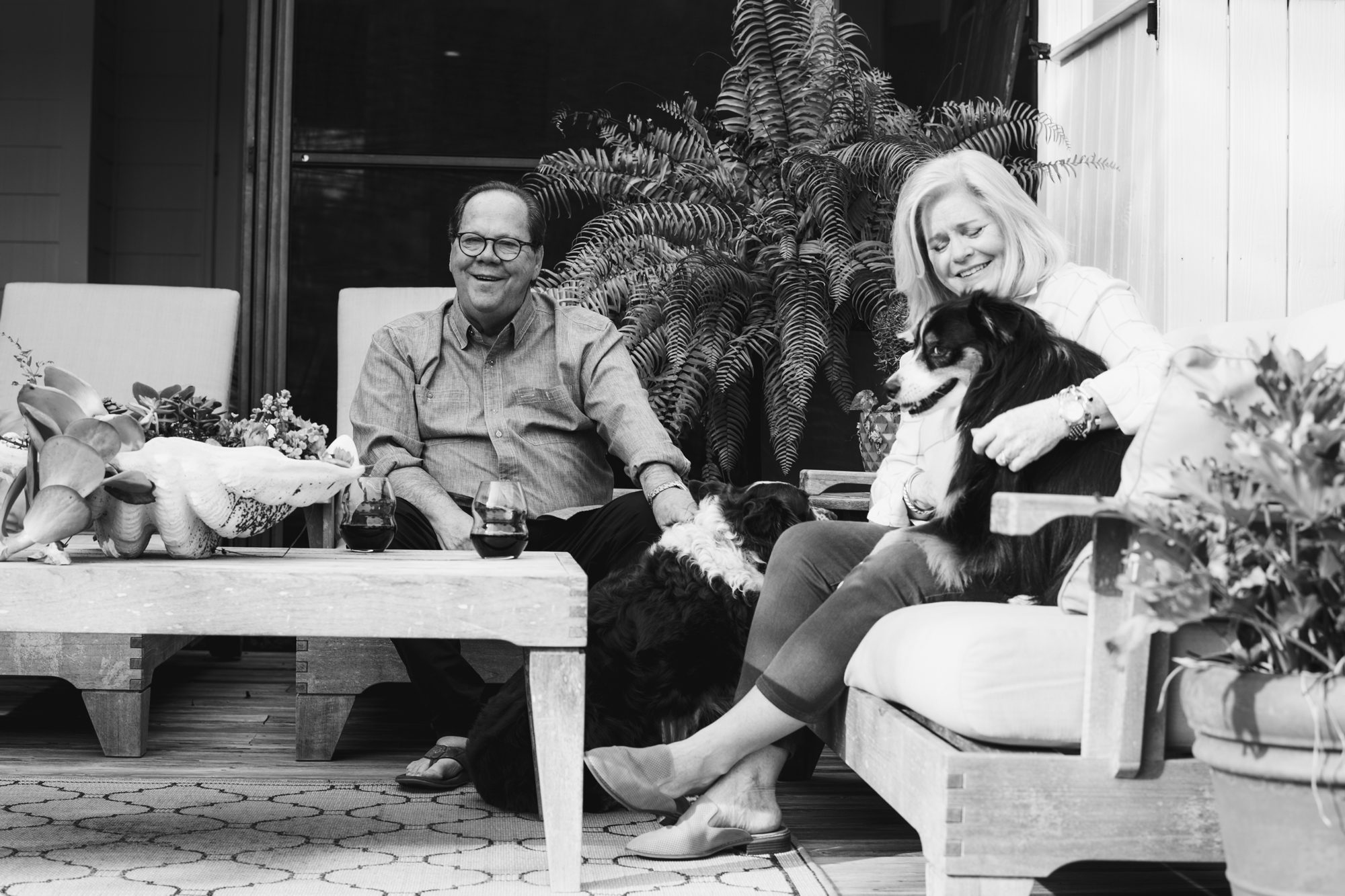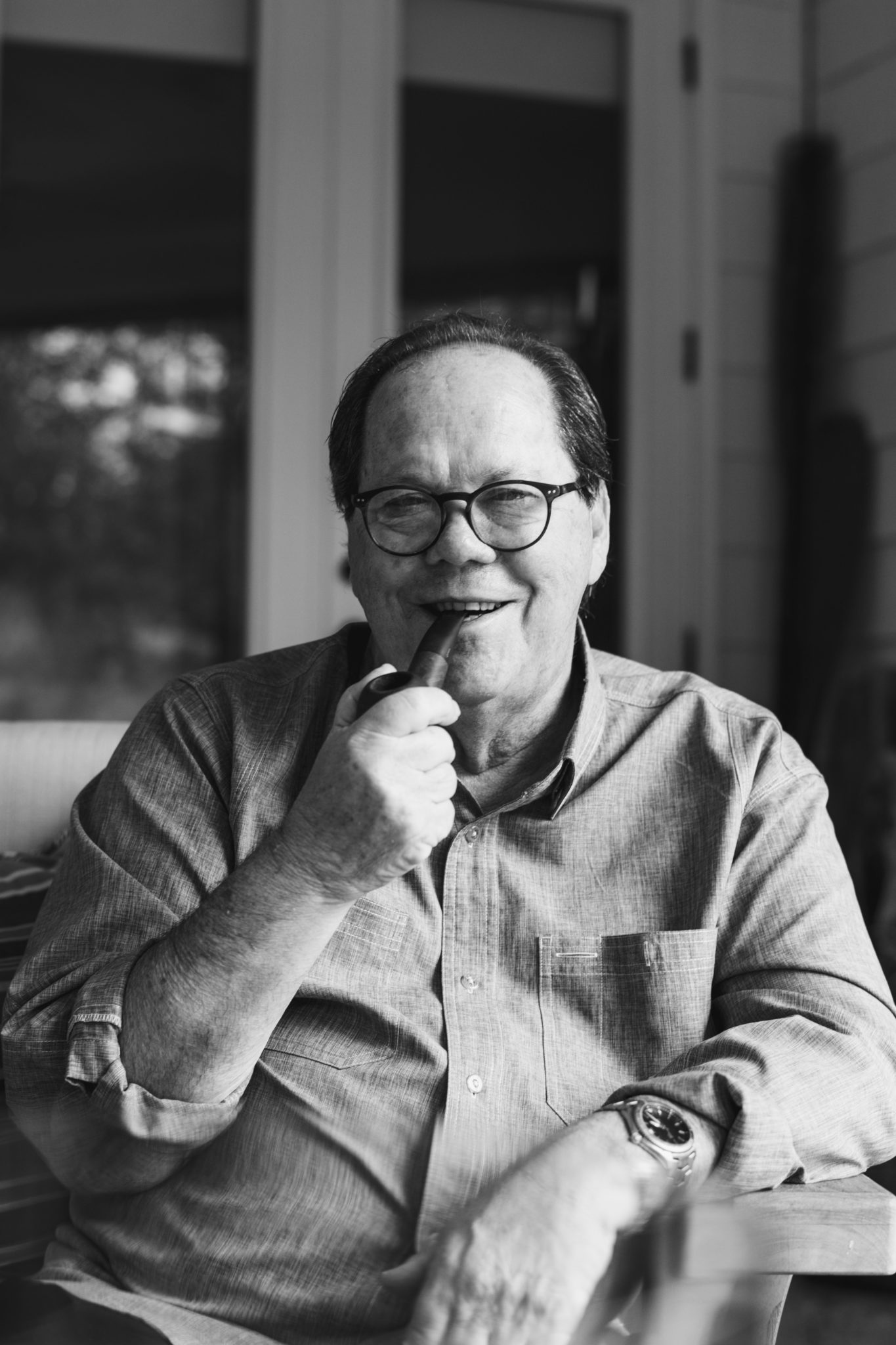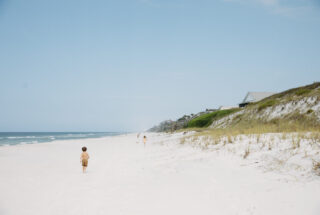My conversation with Tom Christ was punctuated by his observations of the squirrels and birds seen through his window, the barks of his dogs, and dialogue with his wife in the next room. When one of us fell into shadow on the screen, he called for adjustments so that we might see each other better. He paid particular attention to the full moment— not just to our conversation, but to the fullness of his environment and relationship to it and to those within it. There is an easy confidence in him when he speaks of his work. He has been doing it a long time; has seen a lot. He seems to derive the most satisfaction from giving clients what they most want, and that is always the result of mutual trust—he trusts that they will know what they are looking for and share it with him; they trust him to do what he does best. Tom knew early he would be an architect and seemed to have an understanding then that the pull of the field for him was not only the creativity and art of it, but also the relationship with clients, the exercising of inherent gifts, and the freedom of the lifestyle. Even then, he seemed attuned to the full picture.
Cassie: Let’s start at the beginning. Tell me a bit about where you grew up, your early life.
Tom: I was born in Pennsylvania. My family moved to Miami when I was 7. Noise in background. That’s Jamie. She and I are married. She’s an interior designer. We’ve been together for about…
Jamie Christ (from the next room): 39 years.
C: Good for y’all.
T: My family moved to Key Biscayne, which is an island off Miami. That’s where I was raised. It was a great childhood. Every day we were down on the beach, skin-diving, fishing, all this great stuff. Eventually we moved over to the Coconut Grove area, Coral Gables. I still know people in Key Biscayne; we still email and stay in touch. It was a great place for a kid to grow up. It was wonderful. People didn’t lock their doors. They didn’t lock their bikes. It couldn’t have been a better childhood. Later, I went out to Colorado for awhile; I had to see what Colorado was about, and I discovered I didn’t like snow skiing. I loved water skiing, was quite good at it, but I couldn’t snow ski to save my life. During that time I didn’t work for any architects. It wasn’t until I came back to Miami that I started working with some really good residential architects, and I learned so much from that. But I was kind of getting caught up in their style and I wasn’t terribly excited about it. All of a sudden I was in Coconut Grove and I came across this house that it turns out Andrés Duany and Elizabeth Plater-Zyberk did, one of their first houses. The Hibiscus House. It struck a chord. I mean it just, it was exactly what I had thought we should be doing in residential architecture at that time. So I thought, Well, this is really great. I’m just going to go and knock on their door. They rented a little house in Coconut Grove, and that’s where their office was. It was run down. It was all beat up. Guys were smoking their cigarettes and putting them down on the floor, smashing them, which Liz didn’t like at all. But anyway it took me about three attempts to get in because Andrés was always running around. The most high energy guy I’ve ever met. We finally got together and he goes, “Thomas, I want you in the office.” I said, Okay, well, I just came to talk. And he said, “No, you want a job. You have to work for us; you have to.” I said, Okay, I will. I was there after my two-week notice at the other firm was done. We got along fine. Six people in the office at that time. I was the only one who spoke English, except for Andrés and Liz.
C: What do you think it was about you that made him say “just come to work?” What was the connection there that made it so immediate?
T: The architects that I had been working for prior to that were some of the best in the Coconut Grove/Coral Gables area. They were older architects. I had learned a lot and Andrés admired these guys. They were so good. And I think that is why he hired me—because I worked for them. They were in their upper fifties, early sixties. Andrés is just six months older than I am. We were contemporaries, and I guess he felt that because I’d worked for these older guys, I knew a lot. And he wanted me in the office to teach the younger student architects coming up. We had a good time. And then he introduced me to the Seaside project. I think in the back of his head he always thought, “Ah-ha, Tom is familiar with that area up there; he speaks English, and he knows wood construction.” Well, I didn’t. Laughs. I really didn’t. I had told him I knew how a wood building goes together, but that’s it. We started this work in Seaside and it was fun. Seaside back then was brand new. It was just wide open, no streets, nothing. At the end of the day, we’d all run down to the beach, play volleyball, ride our bicycles.
C: When you were growing up, did you have a sense you would be an architect? Were you drawn to design?
T: Yes. Both my grandfathers were artists and built things. They were just really skilled. I learned a lot from them. In any case, I grew up as just a kid in grade school drawing WWI airplanes in great detail. I loved it. The teachers were just, “Tommy, what are you doing? Drawing airplanes again?” Yes, I am. I started working with an architect in Key Biscayne. Just drafting. I was so stunned by this guy. He did such great work; he did it so quickly; he did it freehand. He came in one morning and he had a meeting at 10 or 11 o’clock and he was supposed to present a watercolor of this house that he was working on. He hadn’t even started it. And he said, “Oh, hold on, I can do this,” and he started doing it, and it looked spectacular. The people came in, they loved it, they wrote him a check for $250, and I thought Wow! This is pretty good. I was drawn to the art of it, the creativity, also the freedom. He had a sailboat in the backyard. He lived on Biscayne Bay. It was just a lifestyle that I thought, this is the way to do it. But it was also the art of doing these houses and meeting people and talking to them and trying to understand what they want and then creating this thing. I worked for him for two summers.
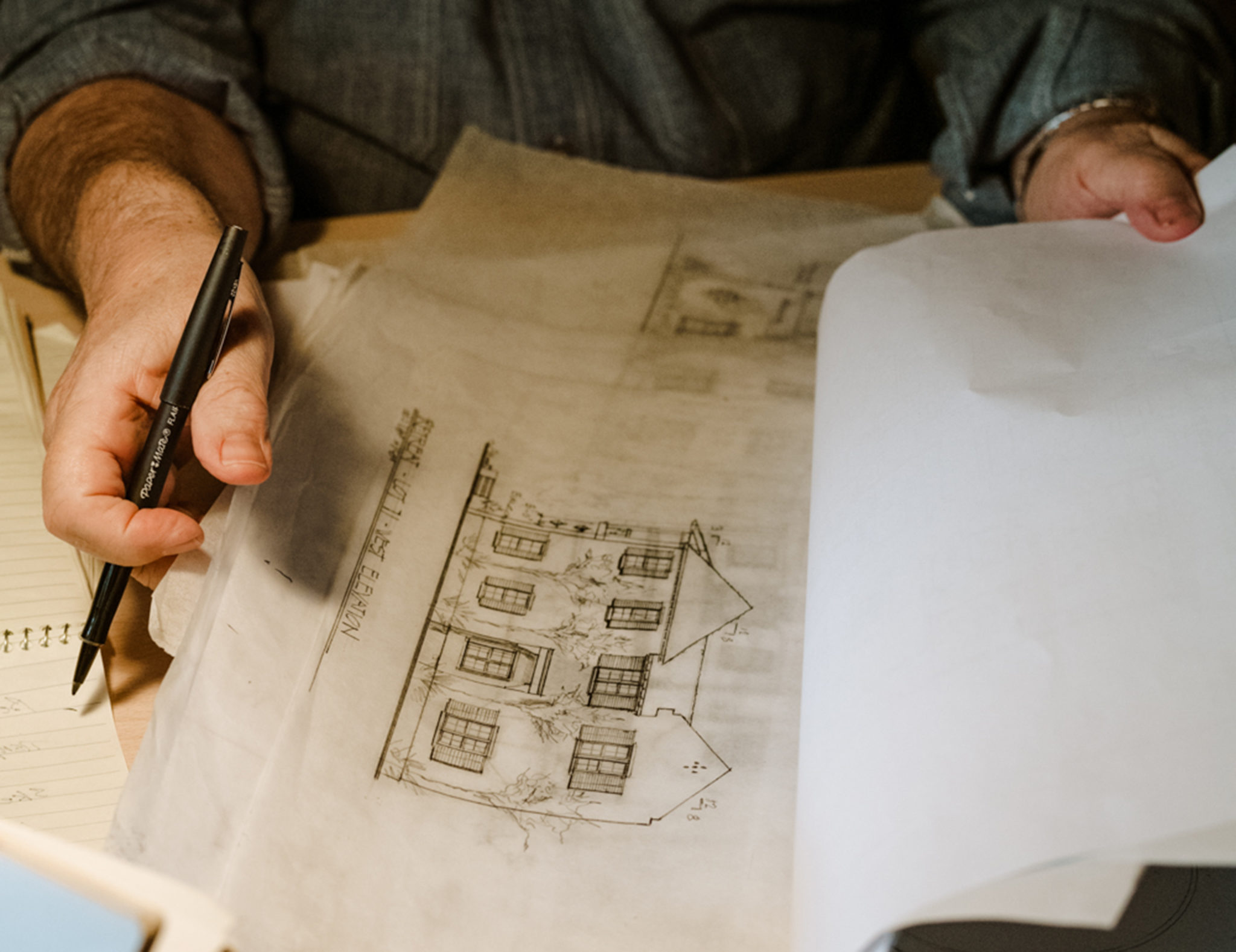

C: How old were you when you were working for him?
T: I was sixteen, seventeen. Then I graduated and I started getting work. The first big job was for a large firm down in Miami, close to the city. This is a good story. The job that I got was with this firm that had me commissioned to do the airplane hangar for 747s. They had just come out. We had a template for how big this plane was so that we could design the building around it. It was a monster. No one had planes like that then. So I was given the task of doing an isometric drawing, kind of like a 3D drawing, to show how all of the trusses and the steel and frame came together. I spent a whole summer on this thing and it was done on plastic mylar, I don’t know if they use it anymore. Plastic sheet of paper and you had special pencils that you had to use and ink and it was very meticulous work. Back then you were allowed to smoke in the office. I smoked a little but the whole room was full of smoke, disgusting, so I picked up a cigarette and took a puff and a little spark came down and hit this drawing. It just went poof, almost disappeared. I patted it down and we saved the drawing but I had to cut out a patch of plastic and redraw it. It was a disaster. All summer and in a flash, nearly gone.
C: So you like the way things go together?
T: Yes. It was also just a challenge to draw this thing. What do you do with a plane that is that big? The hanger was a semicircle and there were doors that folded back, you know, tremendously big doors that let the plane out. It was really something. From there I just started working through really good architects. But I was always drawn to high-end residential work.
C: What was it about the house that you first stumbled upon—the Hibiscus House—what was it that really captured you?
T: It was the massing of the building. It was simple, really simple. And it used window and door details that were painfully simple. You looked at it and just thought that’s just so nice, clean and refreshing. One thing that I learned from Andrés and Liz— there was this room in the back of the office. It was filled with books from all over, mostly from Europe, and I remember Andrés sitting down on the floor and making notes and doodling little ideas and I thought, Well, you know, if you’re an architect and you’re trying to do new things, why would you be looking at old things? He would say, “Thomas, you have to know where you came from.” He used it as a guide. He never copied. It was inspiration. I now have many, many books too, and I do the same thing. I use them. He taught me how to use them and learn from them. And I still do.
C: Great lesson. Can you say a bit about New Urbanism, that school of thought and architecture that inspired communities like Alys Beach? It came to mind when you were talking about your childhood. The idea behind Alys Beach sounds so familiar to how you describe your own growing up.
T: Yes, I think the ideas about New Urbanism that Andrés and Liz had at the beginning were really good. Get out of your car and walk.
C: How do you start in designing a home? It seems like a pretty intimate relationship with the client? Do you have a list of questions or is it kind of more natural, free-flowing?
T: It’s a free-flowing discussion. We meet and talk about how many bedrooms, things like that, and I always try to get out of them the relationship that they want with the house and each other. Do they want the primary bedroom far, far away? Some do and some don’t. There are some basic questions I ask them—are they big cooks? Is cooking a big deal or do they just go out?
C: Is it a show kitchen or a workhorse?
T: Yes. It’s a conversation. I always ask, before they come in—and this is something that never happened in the early days because there wasn’t anything like Houzz or Pinterest. I always ask them if they have had time to cut out magazine clippings of what they like. To give me an idea. They would hesitate—say they didn’t want to make a mistake and embarrass themselves in front of me. Don’t worry about that, I’d say. There’s a thread that goes through all of the pictures. And there really is. So that’s a big help. It’s a good exercise for them, but with the internet there’s also another side to it. I have clients who hired us and then come in with all these little computerized floor plans that do not work. I’m like, where’s the staircase?
C: How much does the landscape, the setting matter to you?
T: Really important. I always tell people that I think there are three things that qualify a good piece of architecture. One is the design of the building; one is the interiors, the detailing of the insides, the furnishings that go along with it; one is the landscaping. It’s so important. It frames things; it creates positive and negative spaces. Some people have a tendency to ignore that component, that landscaping component, and I think it’s really important. I watched my brother for years—he was a landscaper—and he was extremely good. I watched his work finish the composition. And if you don’t have a good interior designer, that can destroy a project too and that’s happened.
C: Do you and your wife (Jamie) work together on projects?
T: She does a lot of them, yes. We have a kind of style that we came up with together.
C: What happens at home when you have a project together? Do you have office hours or is it more of a constant conversation?
T: It’s a constant. We try not to; we try to, after about 6 p.m. or so, step away because you have to.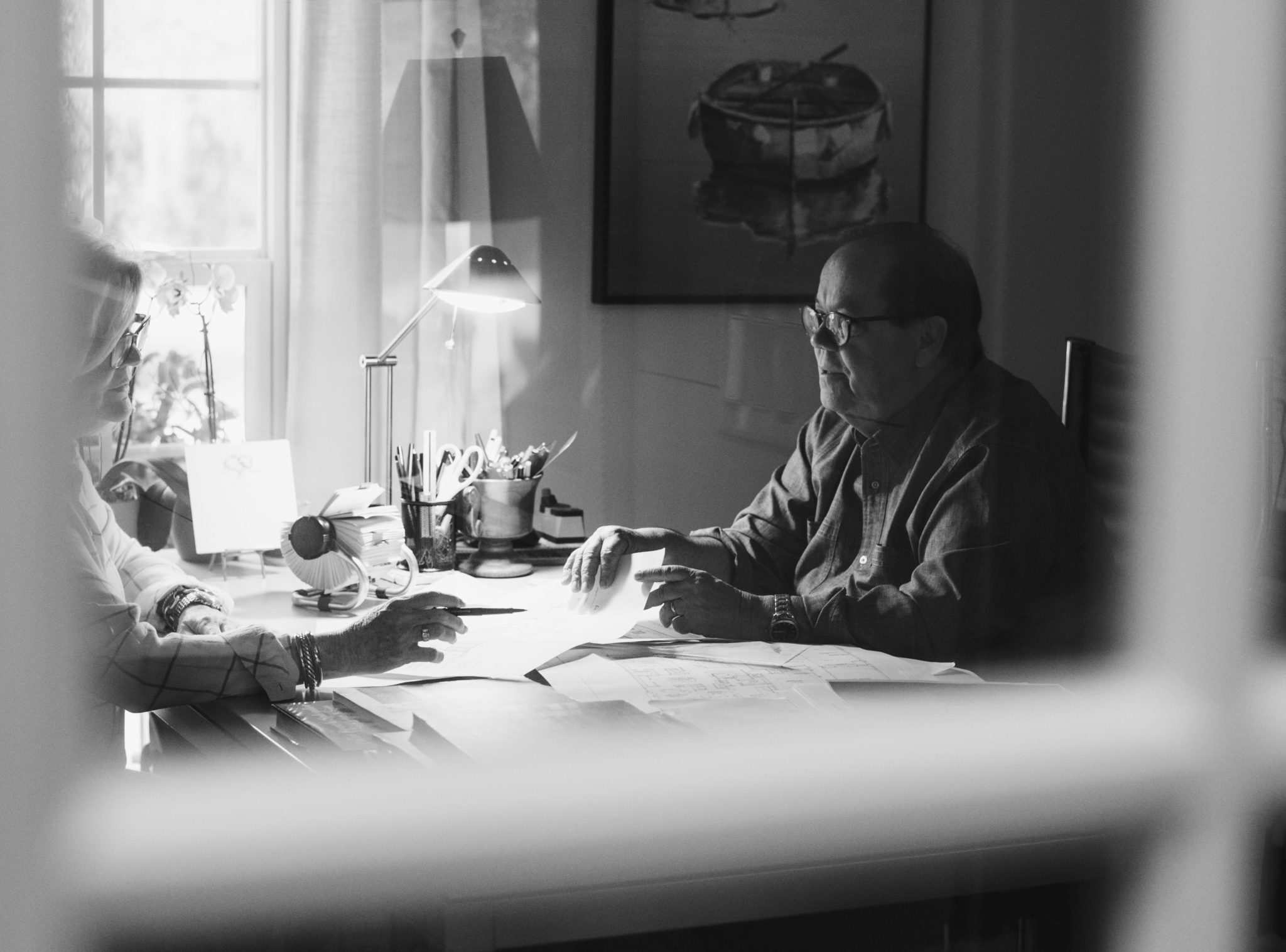

T: I like more modern, contemporary styles. In the beginning years, Seaside sort of forced this Southern vernacular style. We tried to simplify it as best as we could, but still people were hiring us because they wanted a Seaside style. But as the years went on, more contemporary modern architecture started blossoming through the whole area and now it’s much more part of the landscape. When Alys Beach came on, I had so much fun with that. It was a breath of fresh air—all this concrete and white. You could do all kinds of things—little swirls and steps—to stylize the house. Make it a little bit something, a little bit different. It just opened another door. You have almost a free palette.
C: It’s funny you say that. I’ve spoken to a few architects who say that the limitations of designing at Alys Beach—the concrete, the lot size, the white—have actually unleashed new creativity in order to distinguish one work from another. A creative challenge in a good way.
T: It is. We all try to stretch the boundaries and the borders, and they will allow that.
C: I know most of your work is designing second homes. How is that process? Do you find the client is willing to take more risks?
T: In a way, yes. They’re older. The kids are gone and they’re doing it for themselves. Those are nice projects because they’re a little bit bigger, budgets are better, they’re old enough to know what they want.
C: Yes, knowing more of who you are which allows you to know better what you want.
T: Exactly. What you’ve become, what you’ve done in your life. Some of my clients are really interesting.
C: At the end of the day, someone asks you about being an architect, what still makes you light up in interest about your work?
T: The client. When I get a client who knows something about architecture, but knows enough that they don’t want to interfere with the process—those are the kind of people I love to come along and work with. We’re going to be soon working with a lady who I did a house for—never built it, but designed it about twenty years ago—and she’s come back, so that’s going to be a great project.
C: That client, imagine her talking to someone else—what’s the nicest thing she could say about you as an architect? What’s the ultimate compliment from a client you respect and enjoyed working with?
T: I listened to her. Further, she listened to me. I want to hear what they want. But it’s more important that they listen and do what I ask. That sounds kind of arrogant, but it’s really important that they understand they’re coming to me, or any good architect, for guidance. But the architect has to know what they want first, so, yes, that I listened first.
C: So, it’s about trust in a way. They trusted you enough to listen to you.
T: Oh yeah. Some of these people who come to us have watched our work for literally 20 years. They show me pictures of stuff that I had totally forgotten about. That’s a real compliment. That’s really nice.
C: We’re working with an architect who’s done a lot of historic spaces in Louisiana so he’s working on this 1832 house for us. He’s out of New Orleans. It’s been really fun because I am into preservation and am fascinated by these old homes. I love architecture and design. But I’m not an architect and I’m not a designer. I told him all of my ideas and thoughts upfront, and he listened, and then I’ve become very quiet and watched him work. It’s a privilege to watch. What you do is so special.
T: I think it is. It’s an honor to work with people who understand that. It usually comes out quite well.
C: What else inspires you? What in your day-to-day life gives you energy?
T: Laughs.
C: Coffee?
T: Coffee in the morning, yes. I’m just looking out in my backyard here. It’s so beautiful here. We all enjoy that.
C: I live on a beautiful lake in a rural place. We rarely lock our doors. That sense of peace and quiet is really invaluable. I can’t imagine my life without it. I imagine for you coming home at the end of the day from job sites … well, it means a lot to come home.
T: Yes, it does.


C: How do you start your day? Do you have a ritual?
T: Like you mentioned, coffee is a big thing in the morning. I usually sit out and look out at the water. It sounds corny, but I look at the birds, and the dogs are running around the yard chasing rabbits. It really kind of sets my day. It settles me, anchors me.
C: Do you have a favorite place to travel?
T: It used to be to Europe, but that’s not happening right now. Last time we were there we went to Spain and loved it. New York, San Francisco.
C: When you’re not working, where are you?
T: Laughs. We’re working all the time. It’s unbelievable. It’s so busy. Our son lives down in West Palm Beach so we try to get down to see him.
C: It’s interesting. A lot of the architects I’ve interviewed have had similar answers to yours. Which is “I’m always working,” and I wonder how much of architecture really is a lifestyle in the way that you said at the beginning. You don’t turn it off really. The designing mind is always at attention.
T: It’s hard. It’s hard to flip a switch. But we try. You have to stop. Rest a little.
C: A little, anyway. I hope you can. I always leave these interviews very grateful, as I am now. I love hearing about this field and what makes it go.
T: I hope I did alright.
C: You did wonderfully. It was a pleasure.